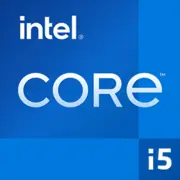Intel Core i5-11260H

Intel Core i5-11260H: A Balance Between Performance and Mobility in 2025
Introduction
Four years after its release, the Intel Core i5-11260H processor remains a popular choice for budget and mid-range laptops. Despite the emergence of new CPU generations, this model remains relevant due to its successful combination of core architecture, energy efficiency, and affordability. Let's explore who this chip is suitable for in 2025 and what tasks it can handle.
Architecture and Technology: Tiger Lake on 10 nm SuperFin
The Core i5-11260H processor belongs to the Tiger Lake-H series, released by Intel in 2021. It is the company's first chip built on the 10nm SuperFin manufacturing process, which provided a 20% performance increase compared to the previous Ice Lake generation.
Key Specifications:
- Cores and Threads: 6 cores (6 physical, 12 logical thanks to Hyper-Threading).
- Clock Frequencies: Base clock — 2.6 GHz, maximum in turbo mode — 4.4 GHz.
- Cache Memory: 12 MB of L3 cache.
- Integrated Graphics: Intel UHD Graphics for the 11th generation (32 EUs, frequency up to 1.45 GHz).
Architecture Features:
- Willow Cove: The new core microarchitecture provides a 15-20% improvement in IPC (instructions per cycle).
- PCIe 4.0: Support for 20 PCIe 4.0 lanes for fast SSDs and external devices.
- Thunderbolt 4: Integrated controller for connecting 4K monitors, external drives, and docking stations.
iGPU: The integrated UHD graphics are suitable for basic tasks (office work, 4K video), but a discrete graphics card is required for gaming. For example, in CS:GO at low settings one can expect 40–50 FPS.
Power Consumption and TDP: 35 Watts with Dynamic Management
The nominal TDP of the processor is 35 watts, but in reality, it operates in the range of 35-45 watts depending on the load and cooling system settings.
Key Points:
- Dynamic Power Consumption: The Intel Dynamic Tuning 2.0 technology automatically adjusts power based on tasks. For example, when working in Word, the processor reduces the frequency to 1.2 GHz, consuming 10-15 watts.
- Thermal Emission: An effective cooling system is required for stable operation in turbo mode. In thin laptops (e.g., Lenovo IdeaPad 5 Pro), the chip can throttle under sustained loads.
Performance: From Office Tasks to Casual Gaming
Office Tasks and Multitasking:
- In PCMark 10 tests, the processor scores 4800-5000 points. This is sufficient for simultaneously working with 20+ tabs in Chrome, Excel spreadsheets, and Zoom.
- Rendering a 10-minute video in Premiere Pro (1080p) takes about 8-9 minutes.
Multimedia:
- Streaming 4K video on YouTube consumes no more than 10-12% of CPU resources.
- Converting FLAC to MP3 (an album of 12 tracks) in iTunes takes 2-3 minutes.
Gaming:
- In combination with a discrete graphics card level with NVIDIA GTX 1650 (commonly found in laptops priced at $800-$1000), the processor achieves:
- Fortnite (1080p, medium settings) — 60-70 FPS.
- Cyberpunk 2077 (1080p, low settings) — 35-40 FPS.
- Turbo Mode: In games, the frequency holds at 4.0-4.2 GHz for 15-20 minutes before dropping to 3.6 GHz due to heat.
Use Cases: Who Is the i5-11260H Designed For?
1. Students and Office Workers: Light rendering of presentations, document handling, video conferences.
2. Freelancers: Photo editing in Lightroom, editing short videos.
3. Casual Gamers: Games like Dota 2 or Genshin Impact when paired with a discrete GPU.
4. Users Replacing Desktops: For those who need mobility without significant compromises.
Examples of 2025 Laptops:
- Acer Swift X (Price: $850) — An ultrabook with RTX 3050.
- HP Victus 15 (Price: $750) — A budget gaming option.
Battery Life: Up to 8 Hours in Mixed Mode
With a 60Wh battery (standard for 15-inch models), the working time is:
- Web Surfing: 6-7 hours.
- Video Playback (1080p): 8-9 hours.
- Gaming: 1.5-2 hours.
Energy-Saving Technologies:
- Intel Speed Shift: Minimizes delays when switching frequencies.
- Adaptix Dynamic Tuning: Machine learning for load optimization.
Comparison with Competitors
1. AMD Ryzen 5 5600H (Zen 3):
- Pros: Better multi-threaded performance (+10-15% in Cinebench R23).
- Cons: Weaker in single-threaded tasks (Geekbench 6 Single Core: 1600 vs 1750).
2. Apple M1 (in MacBook Air):
- Pros: Battery life up to 18 hours, cool operation.
- Cons: Limited compatibility with Windows applications.
3. Intel Core i5-10300H (previous generation):
- Outdated Comet Lake architecture (14nm), 25% slower in multitasking.
Pros and Cons
Strengths:
- High single-threaded performance.
- Support for Thunderbolt 4 and Wi-Fi 6.
- Affordable laptop prices (starting from $700).
Weaknesses:
- Heating in turbo mode.
- Integrated graphics are weaker than those of Ryzen 5 6600H.
Laptop Selection Recommendations
1. Type of Device:
- Ultrabooks (e.g., ASUS ZenBook 14) — for mobility.
- Gaming laptops (MSI Katana GF66) — with cooling featuring 3+ heat pipes.
2. What to Pay Attention To:
- Cooling: Check reviews for throttling issues.
- RAM: Minimum 16GB DDR4-3200.
- Screen: For color work — IPS matrix with 100% sRGB coverage.
Final Conclusion
In 2025, the Intel Core i5-11260H is an optimal choice for those seeking an inexpensive yet powerful laptop for everyday tasks, study, and casual gaming. Its key advantages include support for modern interfaces (Thunderbolt 4, PCIe 4.0), energy efficiency, and stable multitasking performance. If maximum battery life like that of a MacBook or RAW rendering in 8K is not necessary, this processor will serve as a reliable companion for 3-4 years.
Basic
CPU Specifications
Memory Specifications
GPU Specifications
Miscellaneous
Benchmarks
Compared to Other CPU
Share in social media
Or Link To Us
<a href="https://cputronic.com/en/cpu/intel-core-i5-11260h" target="_blank">Intel Core i5-11260H</a>